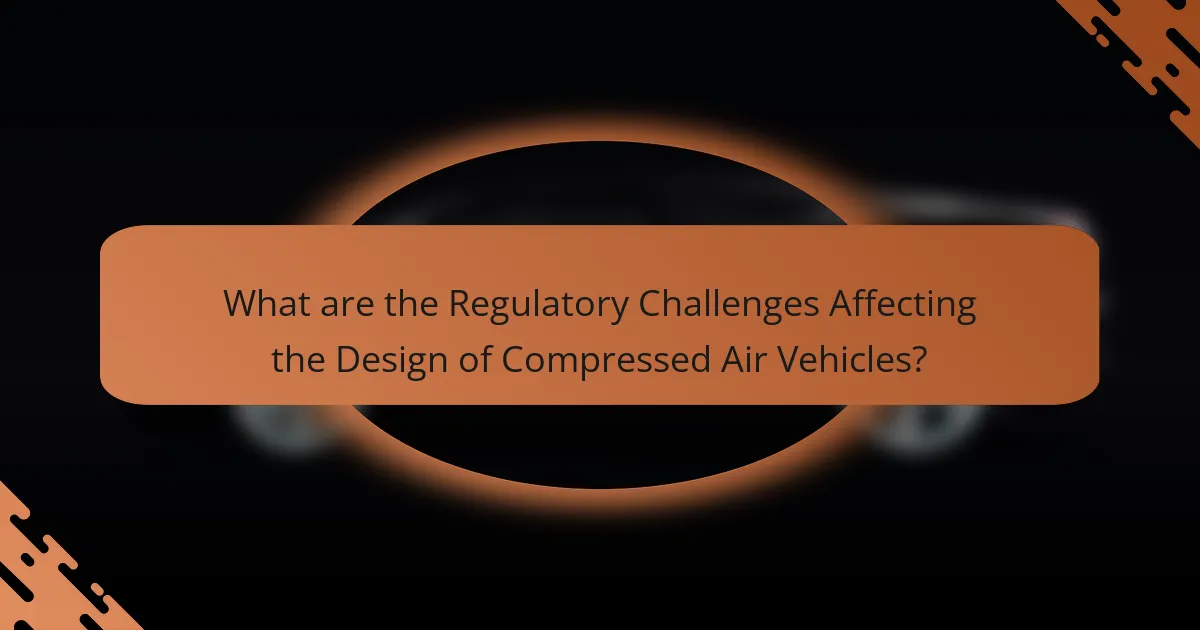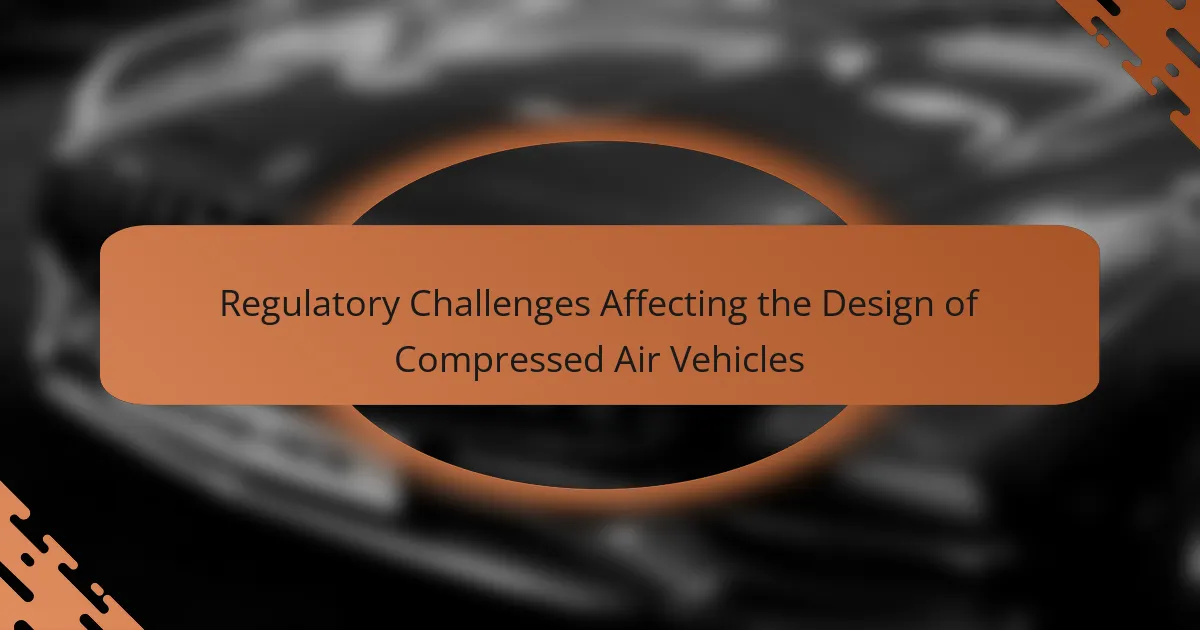Compressed air vehicles are innovative transportation solutions that encounter significant regulatory challenges impacting their design and deployment. Key issues include the need to meet safety standards for vehicle operation, comply with rigorous testing requirements for compressed air systems, and adhere to emissions regulations despite their eco-friendly classification. Additionally, the design process must align with transportation safety guidelines, and manufacturers face obstacles related to the development of necessary refueling infrastructure. The variability of regulations across different regions further complicates the landscape for compressed air vehicle manufacturers. These factors collectively influence the successful integration of compressed air technology into the transportation sector.

What are the Regulatory Challenges Affecting the Design of Compressed Air Vehicles?
Compressed air vehicles face several regulatory challenges. These include safety standards that must be met for vehicle operation. Regulatory bodies require rigorous testing of compressed air systems. Compliance with emissions regulations is also essential, even though these vehicles are considered eco-friendly. Additionally, vehicle design must adhere to transportation safety guidelines. There are also challenges related to infrastructure development for refueling stations. Manufacturers must navigate varying regulations across different regions. These factors collectively complicate the design and deployment of compressed air vehicles.
How do regulations influence the design process of compressed air vehicles?
Regulations significantly influence the design process of compressed air vehicles. They establish safety standards and performance criteria that must be met. Compliance with regulations affects materials selection, engineering practices, and testing protocols. For instance, regulations may dictate the maximum pressure limits for air storage tanks. These limits ensure the structural integrity and safety of the vehicle. Additionally, environmental regulations can impact emissions and noise levels. Manufacturers must design vehicles that align with these environmental standards. Furthermore, regulations can affect the overall cost and timeline of the design process. Adhering to regulatory requirements often requires extensive documentation and testing, which can extend development time. Thus, regulations play a crucial role in shaping the design and functionality of compressed air vehicles.
What specific regulations must be considered during the design phase?
During the design phase of compressed air vehicles, specific regulations include safety standards, emissions regulations, and vehicle performance requirements. Safety standards ensure that the vehicle complies with established guidelines for operation and construction. Emissions regulations govern the allowable limits of pollutants released by the vehicle. Vehicle performance requirements dictate how the vehicle must perform under various conditions. Compliance with these regulations is crucial for legal approval and market entry. Additionally, industry-specific standards may apply, depending on the intended use of the vehicle. These regulations are enforced by governmental and regulatory bodies to ensure public safety and environmental protection.
How do safety standards impact the design of compressed air vehicles?
Safety standards significantly influence the design of compressed air vehicles. They dictate essential parameters like structural integrity and operational safety. Compliance with these standards ensures that vehicles can withstand high-pressure environments. Safety standards also require robust testing and validation processes. These processes assess potential risks associated with compressed air systems. Manufacturers must integrate safety features such as pressure relief valves and secure storage tanks. Additionally, adherence to standards impacts material selection and construction methods. Ultimately, safety standards shape the overall reliability and market acceptance of compressed air vehicles.
What are the key regulatory bodies involved in compressed air vehicle design?
The key regulatory bodies involved in compressed air vehicle design include the National Highway Traffic Safety Administration (NHTSA) and the Environmental Protection Agency (EPA). NHTSA sets safety standards for vehicle design and performance. EPA regulates emissions and environmental impact. Additionally, the Federal Aviation Administration (FAA) may be involved if the vehicle has aviation applications. These organizations ensure compliance with safety and environmental regulations. Their guidelines are essential for the development and approval of compressed air vehicles in the market.
Which governmental agencies oversee the regulations for compressed air vehicles?
The primary governmental agencies overseeing the regulations for compressed air vehicles include the Environmental Protection Agency (EPA) and the National Highway Traffic Safety Administration (NHTSA). The EPA is responsible for setting emissions standards and ensuring environmental compliance. The NHTSA focuses on vehicle safety standards and regulations. Both agencies collaborate to ensure that compressed air vehicles meet safety and environmental requirements. Their regulations influence the design and implementation of these vehicles in the market.
What role do international standards play in the design of these vehicles?
International standards ensure safety, efficiency, and interoperability in the design of compressed air vehicles. They provide a framework that guides manufacturers in meeting essential performance and safety criteria. Compliance with these standards is often required for regulatory approval. For instance, the ISO 26262 standard addresses functional safety in automotive systems. Adhering to such standards helps minimize risks and enhances consumer trust. Moreover, international standards facilitate trade by harmonizing specifications across different markets. This reduces barriers for manufacturers seeking to enter global markets. Overall, international standards play a crucial role in shaping the design and acceptance of compressed air vehicles.
What are the implications of non-compliance with regulations?
Non-compliance with regulations can lead to significant legal and financial repercussions. Companies may face hefty fines imposed by regulatory bodies. Additionally, non-compliance can result in the suspension or revocation of necessary licenses and permits. This can halt production and delay market entry for compressed air vehicles. Furthermore, legal action may arise from consumers or competitors, leading to costly litigation. Non-compliance also damages a company’s reputation and trustworthiness in the industry. According to a study by the Compliance, Governance, and Oversight Council, 70% of organizations experience reputational harm due to regulatory breaches. Ultimately, these implications can severely impact a company’s operational viability and market position.
What risks do manufacturers face if they fail to meet regulatory requirements?
Manufacturers face significant risks if they fail to meet regulatory requirements. These risks include financial penalties imposed by regulatory bodies. Non-compliance can lead to costly legal actions and settlements. Additionally, manufacturers may experience damage to their reputation and loss of consumer trust. Regulatory failures can result in product recalls, which incur substantial costs. In severe cases, manufacturers may face shutdowns or restrictions on their operations. The automotive industry, including compressed air vehicles, is particularly sensitive to regulatory compliance, as safety and environmental standards are strictly enforced. According to a report by the National Highway Traffic Safety Administration, non-compliance can lead to fines exceeding millions of dollars.
How can non-compliance affect the marketability of compressed air vehicles?
Non-compliance can significantly hinder the marketability of compressed air vehicles. Regulatory standards ensure safety, efficiency, and environmental protection. Failure to meet these standards can lead to legal penalties and product recalls. This diminishes consumer trust and brand reputation. Additionally, non-compliance restricts access to key markets. Many regions require adherence to strict regulations for vehicle sales. Without compliance, manufacturers may face barriers to entry. This ultimately reduces sales opportunities and market share. Compliance enhances credibility and competitiveness in the automotive industry.
How do emerging technologies influence regulatory frameworks?
Emerging technologies significantly influence regulatory frameworks by necessitating updates to existing laws and guidelines. As innovations arise, they often outpace current regulations, creating gaps in oversight. For example, advancements in artificial intelligence and autonomous systems require new safety standards. These technologies prompt regulators to assess risks and establish protocols for public safety. The rapid development of compressed air vehicles also challenges traditional vehicle regulations. Authorities must consider unique attributes of these vehicles, such as emissions and energy efficiency. Regulatory bodies often engage with industry stakeholders to create adaptive frameworks. This collaborative approach ensures regulations remain relevant and effective in addressing new technological realities.
What advancements in compressed air vehicle technology challenge existing regulations?
Advancements in compressed air vehicle technology include increased efficiency and storage capacity. These improvements often exceed current safety and emissions regulations. For example, the development of high-pressure storage tanks allows for greater energy density. Such tanks may not meet existing transportation safety standards. Enhanced propulsion systems are also emerging, which can lead to faster speeds. These speeds may surpass regulatory limits set for conventional vehicles. Additionally, innovative materials are being used to construct lighter vehicles. These materials might not be addressed in current regulations, leading to compliance challenges. Overall, these technological advancements create a need for updated regulatory frameworks.
How can regulators adapt to new innovations in vehicle design?
Regulators can adapt to new innovations in vehicle design by updating existing regulations and creating new guidelines. They should actively engage with industry stakeholders to understand emerging technologies. Continuous research and monitoring of advancements in vehicle design are essential. Collaboration with engineers and manufacturers can inform regulatory updates. Pilot programs can test new vehicle designs under real-world conditions. Data collected from these programs can guide regulatory decisions. Additionally, international cooperation can harmonize standards across borders. This approach ensures safety and innovation coexist effectively.
What are the best practices for navigating regulatory challenges in compressed air vehicle design?
Engaging with regulatory challenges in compressed air vehicle design requires a structured approach. First, designers should thoroughly understand relevant regulations, including safety standards and environmental guidelines. This ensures compliance from the outset. Second, early collaboration with regulatory bodies can facilitate smoother approvals. Establishing open lines of communication can clarify expectations and requirements. Third, conducting rigorous testing and validation of designs is essential. Documenting results can provide evidence of compliance and safety. Additionally, staying informed about regulatory changes is critical. Regulations can evolve, impacting design requirements. Finally, leveraging industry best practices and case studies can guide effective design strategies. These practices are supported by historical compliance successes in the automotive sector, where proactive engagement has led to smoother regulatory processes.
How can manufacturers ensure compliance throughout the design process?
Manufacturers can ensure compliance throughout the design process by integrating regulatory requirements from the outset. This involves conducting thorough research on relevant regulations and standards applicable to compressed air vehicles. Manufacturers should engage compliance experts during the design phase to identify potential issues early. Regular audits and reviews of the design against regulatory benchmarks help maintain alignment. Documentation of design decisions and changes is essential for accountability and traceability. Additionally, training design teams on compliance standards fosters a culture of adherence. Employing software tools for compliance tracking can streamline the process. These practices collectively minimize the risk of non-compliance and ensure that the final product meets all regulatory obligations.
What resources are available to assist in understanding regulatory requirements?
Government agencies provide essential resources for understanding regulatory requirements. The U.S. Environmental Protection Agency (EPA) offers guidelines and compliance assistance tools. The National Highway Traffic Safety Administration (NHTSA) publishes standards and regulations for vehicle safety. Industry associations, such as the Society of Automotive Engineers (SAE), provide technical papers and standards. Legal firms specializing in regulatory affairs also offer consulting services. Online platforms host forums and webinars that discuss regulatory updates. Academic institutions conduct research and publish findings on regulatory impacts. These resources collectively aid in navigating complex regulatory landscapes.
The main entity of this article is compressed air vehicles, which are subject to various regulatory challenges that impact their design and deployment. Key regulatory aspects include safety standards, emissions regulations, and performance requirements, all of which significantly influence the design process and materials used. The article discusses the roles of major regulatory bodies such as the NHTSA and EPA, the implications of non-compliance, and the best practices for manufacturers to navigate these challenges effectively. Additionally, it highlights the importance of adapting to emerging technologies and international standards in the evolving landscape of vehicle design.
